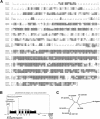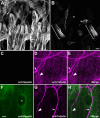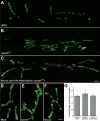Drosophila spastin regulates synaptic microtubule networks and is required for normal motor function
- PMID: 15562320
- PMCID: PMC532392
- DOI: 10.1371/journal.pbio.0020429
Drosophila spastin regulates synaptic microtubule networks and is required for normal motor function
Abstract
The most common form of human autosomal dominant hereditary spastic paraplegia (AD-HSP) is caused by mutations in the SPG4 (spastin) gene, which encodes an AAA ATPase closely related in sequence to the microtubule-severing protein Katanin. Patients with AD-HSP exhibit degeneration of the distal regions of the longest axons in the spinal cord. Loss-of-function mutations in the Drosophila spastin gene produce larval neuromuscular junction (NMJ) phenotypes. NMJ synaptic boutons in spastin mutants are more numerous and more clustered than in wild-type, and transmitter release is impaired. spastin-null adult flies have severe movement defects. They do not fly or jump, they climb poorly, and they have short lifespans. spastin hypomorphs have weaker behavioral phenotypes. Overexpression of Spastin erases the muscle microtubule network. This gain-of-function phenotype is consistent with the hypothesis that Spastin has microtubule-severing activity, and implies that spastin loss-of-function mutants should have an increased number of microtubules. Surprisingly, however, we observed the opposite phenotype: in spastin-null mutants, there are fewer microtubule bundles within the NMJ, especially in its distal boutons. The Drosophila NMJ is a glutamatergic synapse that resembles excitatory synapses in the mammalian spinal cord, so the reduction of organized presynaptic microtubules that we observe in spastin mutants may be relevant to an understanding of human Spastin's role in maintenance of axon terminals in the spinal cord.
Conflict of interest statement
The authors have declared that no conflicts of interest exist.
Figures









References
-
- Benzer S. Genetic dissection of behavior. Sci Am. 1973;229:24–37. - PubMed
-
- Billuart P, Winter CG, Maresh A, Zhao X, Luo L. Regulating axon branch stability: The role of p190 RhoGAP in repressing a retraction signaling pathway. Cell. 2001;107:195–207. - PubMed
-
- Brand AH, Perrimon N. Targeted gene expression as a means of altering cell fates and generating dominant phenotypes. Development. 1993;118:401–415. - PubMed
Publication types
MeSH terms
Substances
Grants and funding
LinkOut - more resources
Full Text Sources
Molecular Biology Databases

